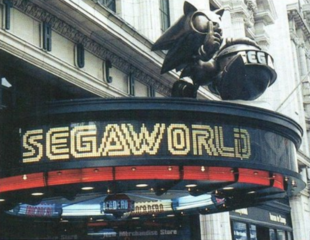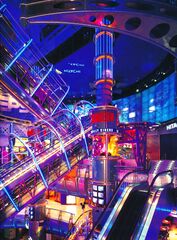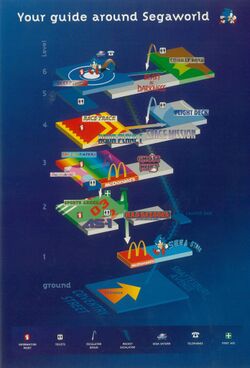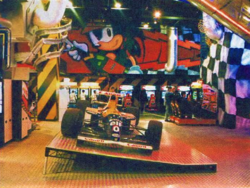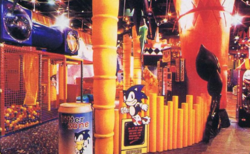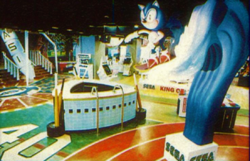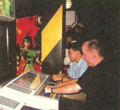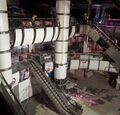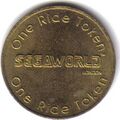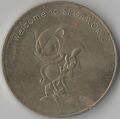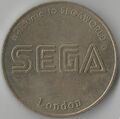Difference between revisions of "SegaWorld London"
From Sega Retro
(→Demise) |
|||
| Line 17: | Line 17: | ||
===Background=== | ===Background=== | ||
A key building of Central London's tourist district, the Piccadilly Trocadero housed various early forms of entertainment venues, until it was given its signature name in 1896 when redeveloped as a large restaurant by J. Lyons Co. After closing in 1965, it re-opened under the name as an entertainment and shopping complex in 1984, with the backing of famous British entrepreneur George Walker{{ref|https://www.independent.co.uk/news/business/old-pro-beats-the-count-once-more-1444917.html}}. By the 1990s, the lower floors were home to numerous virtual reality experiences, a Funland arcade, a Guinness World Records tourist attraction, and a themed walkthrough attraction based on the Alien films; however it was still struggling to find tenants to fill the large space above them, used at that time for more disposable purposes. In 1994{{ref|https://www.standard.co.uk/hp/front/trocadero-for-sale-at-aps210-million-7170560.html}} the building was leased to Burford Group PLC led by Nick Leslau and Nigel Wray, who sought a permanent large-scale tenant for the centre. | A key building of Central London's tourist district, the Piccadilly Trocadero housed various early forms of entertainment venues, until it was given its signature name in 1896 when redeveloped as a large restaurant by J. Lyons Co. After closing in 1965, it re-opened under the name as an entertainment and shopping complex in 1984, with the backing of famous British entrepreneur George Walker{{ref|https://www.independent.co.uk/news/business/old-pro-beats-the-count-once-more-1444917.html}}. By the 1990s, the lower floors were home to numerous virtual reality experiences, a Funland arcade, a Guinness World Records tourist attraction, and a themed walkthrough attraction based on the Alien films; however it was still struggling to find tenants to fill the large space above them, used at that time for more disposable purposes. In 1994{{ref|https://www.standard.co.uk/hp/front/trocadero-for-sale-at-aps210-million-7170560.html}} the building was leased to Burford Group PLC led by Nick Leslau and Nigel Wray, who sought a permanent large-scale tenant for the centre. | ||
| − | [[File: | + | [[File:Yokohama Joypolis Exterior.jpg|thumb|250px|[[Yokohama Joypolis]], the first Joypolis venue and the second indoor theme park opened by Sega under the Amusement Theme Park concept after [[Osaka ATC Galbo]]]] |
| − | At the same time, [[Sega]] were opening their first branded amusement arcades designed to appeal foremostly towards families in Europe | + | At the same time, [[Sega]] were opening their first branded amusement arcades designed to appeal foremostly towards families in Europe{{magref|megapower|2|12}} in an attempt to replicate initial success seen following the same model in Japan, where it had originated. Sega amusement centres like [[Golden Center Game Corner]] had been operated in the country since the late 1960s, and the first branded Sega chain, [[Hi-Tech Land Sega]], was established in the mid 80s, however initial concerted efforts to cater to a wider demographic under the [[En-Joint]] scheme occurred in the late 80s and early 90s. The suburban [[Sega World (Japan)|Sega World]] facilities, characterised by their bright décor, soon thereafter became the predominant chain of venues, supporting larger multi-floor urban centres aimed at young adults that included [[Roppongi GiGO]]. |
| − | In the case of the United Kingdom, operations began with [[Metropolis (venue)|Metropolis]] in November 1992 and continued with a handful of venues using the same Sega World name, as well as others, including Sega Megaworld and Sega Park. Sega itself was quickly becoming one of the biggest consumer brands in the UK at that point, with [[Sega of Europe]] riding on the successes of the [[Sega Master System]] and [[Sega Mega Drive]], and their amusements division, separate from the management dealing with console gaming and driven by distributors [[Deith Leisure]], benefitted from this association to an extent. | + | In the case of the United Kingdom, amusement operations began with [[Metropolis (venue)|Metropolis]] in November 1992 and continued with a handful of venues using the same Sega World name, as well as others, including Sega Megaworld and [[Sega Park]]. Sega itself was quickly becoming one of the biggest consumer brands in the UK at that point, with [[Sega of Europe]] riding on the successes of the [[Sega Master System]] and [[Sega Mega Drive]], and their amusements division, separate from the management dealing with the console gaming market and driven by recently-acquired distributors [[Deith Leisure]], benefitted from this association to an extent, as well as seeing success in its own right by manufacturing hit Sega machines such as ''[[Virtua Racing]]'' in the country. |
Meanwhile, operations in Japan by 1994 had progressed further to the point where Sega had launched their ambitious [[Amusement Theme Park (concept)|Amusement Theme Park]] concept. Under the concept, large-scale indoor theme parks containing interactive attractions, coin-operated arcade machines, and extra amenities designed by the company or in conjunction with others would open. The venues sought to expand Sega's customer base and thusly establish the company as a major force in the out-of-home entertainment sector by providing advanced technology to consumers, as well as to compete with similar parks created by [[Namco]], [[Taito]], and eventually [[SNK]]. The "ATP" business tentatively began with Osaka ATC Galbo in April of that year,{{magref|bemega|1994-05|30}} and was expanded on further with the then-flagship Yokohama Joypolis in July.{{magref|bemega|1994-08|27}} As part of the original plans for the concept, Sega intended to create 100 theme park venues across the world, with the UK earmarked as one of the potential countries to receive one.{{magref|megapower|2|13}} | Meanwhile, operations in Japan by 1994 had progressed further to the point where Sega had launched their ambitious [[Amusement Theme Park (concept)|Amusement Theme Park]] concept. Under the concept, large-scale indoor theme parks containing interactive attractions, coin-operated arcade machines, and extra amenities designed by the company or in conjunction with others would open. The venues sought to expand Sega's customer base and thusly establish the company as a major force in the out-of-home entertainment sector by providing advanced technology to consumers, as well as to compete with similar parks created by [[Namco]], [[Taito]], and eventually [[SNK]]. The "ATP" business tentatively began with Osaka ATC Galbo in April of that year,{{magref|bemega|1994-05|30}} and was expanded on further with the then-flagship Yokohama Joypolis in July.{{magref|bemega|1994-08|27}} As part of the original plans for the concept, Sega intended to create 100 theme park venues across the world, with the UK earmarked as one of the potential countries to receive one.{{magref|megapower|2|13}} | ||
Revision as of 12:01, 22 May 2021
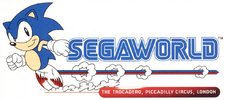
|
| SegaWorld London |
|---|
| Location: The Trocadero, Piccadilly Circus London, United Kingdom |
| Google maps: 51.510490,-0.133022 |
| Opened: 1996-09-07[1] |
| Closed: 1999-09-07[2] |
SegaWorld London was a Sega World indoor theme park opened by Sega. Housed within the London Trocadero complex, the site became the flagship Sega amusement centre in Europe upon opening in September 1996, and was the first theme park venue to be opened outside of Japan by the company.
It was claimed to be the largest indoor theme park in the world, occupying an area of 10200m² on seven floors[3] and making it the largest venue to be developed and wholly ran by Sega, but has since closed permanently.
Contents
History
Background
A key building of Central London's tourist district, the Piccadilly Trocadero housed various early forms of entertainment venues, until it was given its signature name in 1896 when redeveloped as a large restaurant by J. Lyons Co. After closing in 1965, it re-opened under the name as an entertainment and shopping complex in 1984, with the backing of famous British entrepreneur George Walker[4]. By the 1990s, the lower floors were home to numerous virtual reality experiences, a Funland arcade, a Guinness World Records tourist attraction, and a themed walkthrough attraction based on the Alien films; however it was still struggling to find tenants to fill the large space above them, used at that time for more disposable purposes. In 1994[5] the building was leased to Burford Group PLC led by Nick Leslau and Nigel Wray, who sought a permanent large-scale tenant for the centre.

At the same time, Sega were opening their first branded amusement arcades designed to appeal foremostly towards families in Europe[6] in an attempt to replicate initial success seen following the same model in Japan, where it had originated. Sega amusement centres like Golden Center Game Corner had been operated in the country since the late 1960s, and the first branded Sega chain, Hi-Tech Land Sega, was established in the mid 80s, however initial concerted efforts to cater to a wider demographic under the En-Joint scheme occurred in the late 80s and early 90s. The suburban Sega World facilities, characterised by their bright décor, soon thereafter became the predominant chain of venues, supporting larger multi-floor urban centres aimed at young adults that included Roppongi GiGO.
In the case of the United Kingdom, amusement operations began with Metropolis in November 1992 and continued with a handful of venues using the same Sega World name, as well as others, including Sega Megaworld and Sega Park. Sega itself was quickly becoming one of the biggest consumer brands in the UK at that point, with Sega of Europe riding on the successes of the Sega Master System and Sega Mega Drive, and their amusements division, separate from the management dealing with the console gaming market and driven by recently-acquired distributors Deith Leisure, benefitted from this association to an extent, as well as seeing success in its own right by manufacturing hit Sega machines such as Virtua Racing in the country.
Meanwhile, operations in Japan by 1994 had progressed further to the point where Sega had launched their ambitious Amusement Theme Park concept. Under the concept, large-scale indoor theme parks containing interactive attractions, coin-operated arcade machines, and extra amenities designed by the company or in conjunction with others would open. The venues sought to expand Sega's customer base and thusly establish the company as a major force in the out-of-home entertainment sector by providing advanced technology to consumers, as well as to compete with similar parks created by Namco, Taito, and eventually SNK. The "ATP" business tentatively began with Osaka ATC Galbo in April of that year,[7] and was expanded on further with the then-flagship Yokohama Joypolis in July.[8] As part of the original plans for the concept, Sega intended to create 100 theme park venues across the world, with the UK earmarked as one of the potential countries to receive one.[9]
Development
At first, the Trocadero building was intended to be the site for a smaller Sega World amusement arcade, scheduled to open shortly after Sega World Bournemouth in 1993.[6] The original venue appears to have never came to fruition - many of Sega's popular arcade machines could already be found in other parts of the venue, with its Funland arcade notably operating R360[10] and Virtua Formula[11] units. Whilst continually expanding operations in Europe, Sega originally planned to create their first indoor theme park venue outside of Japan in the United States during 1994; executives held high-level talks with Universal/MCA[12] and later Disney to create a joint venture,[13] however these failed, instead resulting in the company's exhibition space at Innoventions and the GameWorks mixed-use entertainment centres.
By January 1995, an agreement had been reached with Burford Group to create a venue under the Amusement Theme Park concept.[14] Named "SegaWorld" to differentiate itself from the Sega World amusement arcades, £45 million in funding was allocated for its creation, with the park proposed to use over 100,000 square feet of the Trocadero site.[15] Contracts were made with Tibbatts Associates[16] and RTKL[17] for its design, Mustoe Merriman and Motive[18] for marketing, and Crown Society[19] for the planning of corporate hospitality packages, among other firms. During the development process, a separate company, Trocadero PLC, was spun off from Burford Group to handle the running of the centre as a whole.[20]
Early promotion of the centre was made in Ultimate Future Games magazine during 1995. A £1.5 million advertising campaign[21] was then initiated in April 1996, with a number of press events and further coverage in several other magazines. Shortly before the opening, a sponsorship deal was made by Trocadero PLC with Pepsi, who would later fund the Pepsi IMAX Theatre and Pepsi Max Drop that could be found in the building. Despite the added exposure created by it, these deals were for the Trocadero itself and did not benefit Sega directly[22], and the attractions were located outside of their space in the main atrium area, alongside other unrelated businesses.
Opening
SegaWorld London was opened over a two week period in 1996 with three separate events - a privately held pre-launch preview on 26 August[23], the official public launch day on 7 September, and a special evening event held for selected ECTS Autumn 1996 press attendees on the following day,[24] of which the UK launch party of Nights Into Dreams was also included.[25] The public launch in particular was heavily promoted in the media and attended by numerous celebrities, with Robbie Williams, Jools Holland, and Anneka Rice among them.[26]
The launch of the venue did not run smoothly. On the day of the public opening, longer than anticipated queues were said to be common for most attractions, and a lack of enthusiasm for their supposed technological feats prevailed.[27] Particularly damning was Nick Leslau's immediate assessment of the site - having offered Sega the chance to create the park and overseeing its development with enthusiasm, he was dissuaded by what he saw on the opening day. Leslau took criticism for his investment in the venture, and would later remark "Sega could not deliver what they said they'd deliver... People were queuing for ages... It was a question of over-anticipation and under-delivery."[28].
The policies of the park would also prove to be controversial. On top of the £12 and £9 admission fees for each individual adult and child, every arcade machine (costing up to £3) was still coin-operated; as well as this, no food or drink was permitted to be taken in, with it available for purchase at snack bars and McDonalds outlets located on the premises. The moves were seen as excessive in some reviews - Computer & Video Games critiqued them with "Whoever said that Robotnik is supposed to be the fascist dictator?" in reference to the promotional leaflet's description of the rules supposedly made by Sonic the Hedgehog himself.[1] The opening of the venue largely came to be regarded as a PR disaster in retrospect.[29]
Demise
Despite a continued investment, with consistent updates to its roster of arcade games and events (including Virtua Fighter 3 Japan Vs England, which saw Sega officially provide travel to London for Japanese VF3 players[30]), the centre regularly struggled to meet its expected profit targets. Maintenance issues were also immediately faced, with a number of attractions reportedly developing technical difficulties weeks after the opening.[31][32] Discouraged by the botched launch and ongoing problems in its running, Nick Leslau quit his managerial role, and ex-First Leisure executives John Conlan and Nick Tamblyn joined Trocadero PLC.[20] Under Conlan and Tamblyn, the company moved into acquiring more intellectual property to be implemented into the Trocadero alongside other London locations, and Sega were mainly treated with disdain internally - Conlon would later claim that he had "been trying to get rid of SegaWorld" since the day he joined.[2]
Sega had hoped to attract 1.75 million visitors to the facility in its first full year of operation, but ultimately fell short of this,[21] recording a loss of £1 million. Entry fees had been dropped to £2 in December 1996, and then scrapped entirely December 1997 to increase footfall and reposition the centre's status as a large amusement arcade[33] - the move worked in theory, with annual visitor numbers increasing to 4 million in 1998.[21] However, it did little to remedy the financial situation, with the new pay-as-you-go model for both the coin-operated arcade machines and attractions not achieving its expected returns. During this time, the Funland arcade opened a basement branch and Trocadero management placed arcade machines around the central atrium outside of SegaWorld; alongside the popular Wonder Park arcade operated by Namco in the same area,[34] these further diverted potential profits away from SegaWorld, which was operating at a £2 million loss by the time of 1998.[27]
Sega's ten-year deal with Trocadero PLC included an early termination clause if a £3 million profit had not been recorded after three years.[22] This was exercised in September 1999, with their direct involvement in SegaWorld London ceasing exactly three years to the day it had opened. The failure of SegaWorld soon became emblematic of wider problems within the company and the worldwide amusement industry itself during the early 2000s; Sega's initiatives to open and run amusement centres around the world were largely discontinued thereafter, with many operations similarly ceased or outsourced to other companies, and alongside similar parks opened by rival companies, the majority of their Amusement Theme Park venues were scrapped entirely or downsized. Sega's former floors of the Trocadero were sublet to Family Leisure (established[35][36] by Martin Bromley), operators of numerous arcades in London,[2] which included the Funland centre situated on the lower floors of the Trocadero. Plans began to rename Sega's space accordingly, and the centre was officially stripped of any remaining SegaWorld branding by February 2000, with the Trocadero building also leased back to Burford Group at the same point in time.[37]
Aftermath
Assuming full control of the former SegaWorld space as part of the sublet agreement, Family Leisure closed their basement Funland branch, joined the two original floors up to the upper six, and ran them together as a large Family Entertainment Centre. Most of the Sega-era features were taken out and replaced with new attractions intended to broaden the appeal of the centre, including a bowling alley, sports bar, and conventional fairground rides.[38] A new façade incorporating balconies and neon signs was also constructed to the right of the Trocadero's central atrium, though décor from the old themes was kept intact in some areas.
Funland was operating largely unopposed in its area by the time of the early 2000s, with Namco also closing their Wonder Park arcade around the same time as SegaWorld,[39] however, dedicated playerbases for some arcade games in the capital had dwindled, and Family Leisure faced staffing issues. An ongoing problem with antisocial behaviour and illegal activity subsequently developed at the centre, with incidents including armed robberies.[40] To mitigate the strains on the centre, management renewed Funland's lease to only cover two floors in September 2002,[41] permanently closing the upper four in the process. As a result, the second rocket escalator that went to them was stopped and blocked off.
At no point was the complex significantly revamped, meaning traces of the SegaWorld layout and removed attractions still existed for much of the rest of the decade. Numerous wall murals remained in the closed off floors, most significantly artwork of a large aircraft control panel on the back wall of what used to be the Flight Deck.[42] The first rocket escalator was kept operational to take visitors up to what was left of Funland, where a walk-way had been made to join the second floor up to the midway podium between the two escalators.
Despite finding success in rhythm action games during the 2000s, working standards at Funland had decayed, and the venue ceased operations altogether in July 2011[43] after internal money management issues and an acrimonious lease dispute with the Trocadero's new property owners, Criterion, who had desired to renovate the Trocadero site to become a hotel since their purchase of it in 2005.[44] After this, the centre's machines were bought by other arcades at auction, shifted to the front of Funland's shuttered entrance, and maintained by two makeshift venues in the basement, until the final closure of the Trocadero as an entertainment centre in February 2014.[45] Part of SegaWorld's former space is now occupied by a Zedwell hotel.[46]
Layout
Taking up over 100,000 of the Trocadero's 600,000 square feet, SegaWorld London was a seven-floor indoor amusement theme park. Whilst billed as such, much of its floor space was taken up by its large amount of coin-operated arcade machines, including full-size deluxe iterations of games and imported versions scarcely seen elsewhere in the UK. Alongside numerous other Sega venues, it was specifically used for the location testing of both upcoming and never-released titles, as well as holding occasional officially-organised events.
After entering the Trocadero building through its shopping arcade area, visitors would be taken up the "rocket escalator", (16.43m in length (with 80m of handrail), 31.5 tons in weight and 193 steps[14] (although it was technically two escalators, not one)), running through the main atrium containing other Trocadero tenants, to the sixth "level" (floor). This acted as the park's reception, with each subsequent floor based around differing themes and concepts. The arcade machines on these floors were generally kept in line with the designated theming, and various other attractions and amenities could be found between them, including a McDonalds restaurant and other refreshment stalls.
The subsequent floors themselves were connected and accessible to visitors by working their way down a further series of escalators and travelators, frequently situated on the left and right sides at the top of the Trocadero's main atrium area, as well as several static staircases. Also originally located in the atrium was the official Sega Shop, which sold merchandise exclusive to the park and small quantities of other consumer products created by Sega. Alongside a second McDonalds outlet directly opposite it, the retail unit that housed the shop was positioned to the left of the bottom of the exit escalator, until the shop's later upstairs relocation to the Sports Arena.
Level 6: Reception
At the reception, visitors could obtain tokens and attraction tickets, have photos taken with statues of Sonic the Hedgehog (the de-facto mascot of the park), and try a selection of free to play Sega Saturn consoles. Also housed on the floor was an interactive information centre, video screens displaying promotional films, and the first attraction, Beast In Darkness, with its exit leading out onto the following floor.
Level 5: Combat Zone
The Combat Zone floor was more akin to a dimly-lit conventional amusement arcade, featuring black and yellow striped décor and no attractions. Its space was instead devoted to a selection of over 50 action games, with genres ranging from fighting to shooting. At launch, games included Virtua Cop 2 and Fighting Vipers, as well as non-Sega titles like Time Crisis and Area 51.
Level 4: Race Track
Boasting extensive theming, with replicas of race cars in its walls and giant traffic lights, the Race Track featured over 70 racing games, most notably back to back 8 player deluxe setups of Daytona USA and Manx TT Superbike with live commentators. The floor's attraction, officially known as Aqua Nova at previous Sega amusement theme parks, was renamed and localised under the name of Aqua Planet.
One of Damon Hill's FW15C racing cars from the 1993 Formula One season was also situated on the floor for photo opportunities. During that season, Hill drove with Alain Prost for Williams, who were famously sponsored by Sega at the time. Incidentally, Prost partly owned the La Tête Dans Les Nuages entertainment centre chain in France, whose Paris and Amiens locations contained Centre Sega amusement arcades.
Level 3: Flight Deck
Themed around aviation and aircraft, the Flight Deck level housed 20 "flying" games, taking in titles such as Sky Target and Wing War, as well as Namco's Prop Cycle. At one point in time, both Dennou Senki Net Merc and G-LOC: Air Battle R360 machines were located on the floor, the former of which was originally stationed in the Combat Zone at launch.
Promoted as one the venue's premier attractions, much of the Flight Deck's space was taken up by VR-1: Space Mission. Hanging from the floor's ceiling was the first commercially available ex-RAF Harrier Jump Jet, transported to the venue in the months prior to its by being towed through London on a boat for a PR event and subsequently reported on by Computer & Video Games magazine.[47]
Level 2: The Carnival
The Carnival, a brightly lit area with décor loosely based on the Sonic the Hedgehog games, contained over 80 arcade machines, most typically UFO Catchers and prize redemption. A prize desk to reward ticket payouts accommodated these. Also located on the floor was the "Segakids" section, featuring a McDonalds outlet and indoor play equipment for young children.
Initially only one attraction was installed on the floor, Ghost Hunters (localised and adapted under the name of Ghost Hunt); this number would later increase to three with the additions of the small House of Grandish 3D sound room attraction developed by Human in late 1996 and the Power Sled simulator after 1997.
Level 1: Sports Arena
The final floor, Sports Arena, housed over 90 sports games. These included Sega-made examples such as Virtua Striker and Sega Bass Fishing, as well as the more unconventional SegaSonic the Hedgehog and Sonic the Fighters cabinets at one stage. On opening day, Virtua Fighter 3's official UK launch occurred on the level.
The floor housed two attractions, Mad Bazooka and a pair of AS-1 motion simulators. The former was closed and removed around 1998; the Sega Shop, originally located to the left of the exit escalator, latterly moved upstairs to the space the attraction likely once occupied.
Major attractions
Gallery
Merchandise
Magazine articles
- Main article: SegaWorld London/Magazine articles.
Promotional material
Sizzle reel for the centre circa early 1996
External links
- SegaWorld London homepage (archived)
References
- ↑ 1.0 1.1 File:CVG UK Freeplay 07.pdf, page 1
- ↑ 2.0 2.1 2.2 https://www.thisismoney.co.uk/money/news/article-1577337/Chorions-Segaworld-game-over.html
- ↑ Press release: 1996-09-12: INTERNATIONAL MANAGER : Sega Tests the Theme-Park Route
- ↑ https://www.independent.co.uk/news/business/old-pro-beats-the-count-once-more-1444917.html
- ↑ https://www.standard.co.uk/hp/front/trocadero-for-sale-at-aps210-million-7170560.html
- ↑ 6.0 6.1 Mega Power, "September 1993" (UK; 1993-08-19), page 12
- ↑ Beep! MegaDrive, "May 1994" (JP; 1994-04-08), page 30
- ↑ Beep! MegaDrive, "August 1994" (JP; 1994-07-08), page 27
- ↑ Mega Power, "September 1993" (UK; 1993-08-19), page 13
- ↑ HiScore, "15 Juli - 15 September" (DK; 1993-07-15), page 26
- ↑ Computer & Video Games, "April 1994" (UK; 1994-03-15), page 86
- ↑ Press release: 1993-07-04:Sega Takes Aim at Disney's World
- ↑ https://www.vrfocus.com/2017/07/the-virtual-arena-the-virtual-theme-park-part-1/
- ↑ 14.0 14.1 Computer & Video Games, "June 1996" (UK; 1996-05-09), page 57
- ↑ Ultimate Future Games, "May 1995" (UK; 1995-04-01), page 17
- ↑ https://www.designweek.co.uk/issues/27-april-1995/tibbatts-leads-segaworld-project/
- ↑ https://www.designweek.co.uk/issues/8-august-1996/rtkl-puts-the-future-into-the-trocadero/
- ↑ https://www.campaignlive.co.uk/article/news-mustoe-merriman-motive-win-pounds-1m-segaworld-work/16248
- ↑ https://segaretro.org/File:SegaWorldLondon_CorporateEntertainment_Back.jpg
- ↑ 20.0 20.1 https://www.referenceforbusiness.com/history2/96/Urbium-PLC.html
- ↑ 21.0 21.1 21.2 https://www.ipo.gov.uk/t-challenge-decision-results/o15203.pdf
- ↑ 22.0 22.1 Marketing Week: Sega makes a play to win back top UK slot
- ↑ File:SegaWorldLondonTicket_Back.jpg
- ↑ Mega Fun, "11/96" (DE; 1996-10-16), page 76
- ↑ Computer & Video Games, "September 1996" (UK; 1996-08-11), page 52
- ↑ https://www.diomedia.com/search/opening+of+segaworld.html
- ↑ 27.0 27.1 http://letslookagain.com/2014/01/segaworld/
- ↑ https://www.theguardian.com/business/2011/jul/28/nick-leslau-brings-his-millions-to-londons-ancient-harbour
- ↑ https://www.indianpost.co.uk/2011/07/nick-leslau-brings-his-millions-to-londons-ancient-harbour/
- ↑ Sega Saturn Magazine, "1996-20 (1996-11-22)" (JP; 1996-11-08), page 45
- ↑ https://archive.org/details/economicsofleisu0000_2nded/page/228/
- ↑ https://www.wsj.com/articles/SB845578365335376000
- ↑ http://letslookagain.com/tag/segaworld-london/
- ↑ https://www.independent.co.uk/life-style/games-the-final-frontier-1297110.html
- ↑ Press release: 2008-09-08: Industry icon Marty Bromley passes away
- ↑ http://vegauniverse.com/corporb.htm (Wayback Machine: 2002-04-10 15:23)
- ↑ https://www.investegate.co.uk/burford-holdings-plc--buo-/rns/chorion-leases-taken-back-at-london-trocadero/200002020813158264E/
- ↑ http://www.proun.co.uk/leisure#/funland/
- ↑ https://carlankawrites.medium.com/searching-for-street-fighter-f658334a1d3
- ↑ http://news.bbc.co.uk/1/hi/uk/1096914.stm
- ↑ https://www.casemine.com/judgement/uk/5a8ff71960d03e7f57ea785c
- ↑ https://3.bp.blogspot.com/-IQO53Njw_qI/WdjMwqRsJWI/AAAAAAAAAaI/TaH5RcMm7c4wOFWYltpE-e7rAV380BPRwCLcBGAs/s1600/trocclosed6.jpg
- ↑ https://www.facebook.com/FunlandTrocadero/posts/10150250215896250
- ↑ https://www.standard.co.uk/news/london/trocadero-to-be-transformed-into-tokyostyle-pod-hotel-8052753.html
- ↑ https://ukarcaderacers.wordpress.com/2014/02/14/london-trocadero-will-close-for-good-on-february-25-2014/
- ↑ https://www.zedwellhotels.com/rooms
- ↑ Computer & Video Games, "August 1996" (UK; 1996-07-11), page 8
- ↑ https://i.ibb.co/2dpHbqg/Cucciolo-IT-Poster-1998.jpg (archive.today)
| Sega-related venues in the United Kingdom |
|---|
| Sega World |
| Bournemouth (1993-2000) | London (1996-1999) | Tamworth (199x-xxxx) | Wolverhampton (199x-xxxx) | Birmingham (199x-xxxx) |
| Sega Park |
| Glasgow (1993-200x) | Acton (1994-199x) | Colindale (1994-2008) | Southampton (1996-2013) | Wood Green (199x-xxxx) | Basildon (199x-2005) | Reading (199x-199x) | Bristol (199x-200x) | Harlow (1997-2003) | Tower Hill (xxxx-200x) | Harrow (200x-200x) | Holborn (200x-200x) | Brighton (2002-2006) |
| Sega Zone |
| Brixton (199x-xxxx) | Catford (199x-xxxx) | Woolwich (199x-xxxx) |
| Sega Megaworld |
| Croydon (199x-199x) | Harrow (199x-199x) | Romford (199x-199x) |
| Sega Prize Zone |
| West Midlands (2015-2020) | Southport (2016-2019) | Hatfield (2016-2020) |
| Others |
| Metropolis (1992-199x) | Planet Sega Queensway (199x-200x) |
